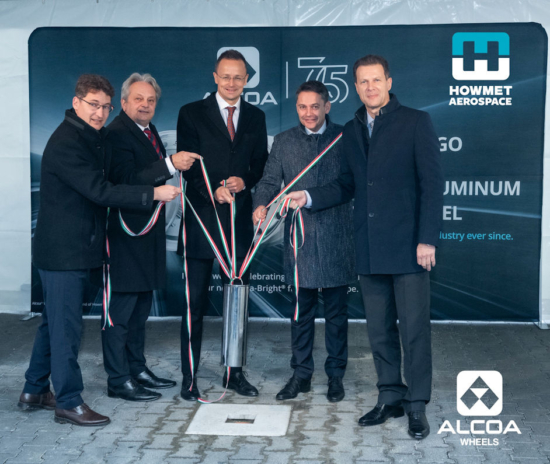Strong demand for Alcoa Dura-Bright wheels – Groundbreaking for Hungary plant expansion
 The expanded plant in Hungary will “significantly expand” capacity in Europe to produce forged aluminium Alcoa wheels (Photo: Alcoa Wheels Europe)
The expanded plant in Hungary will “significantly expand” capacity in Europe to produce forged aluminium Alcoa wheels (Photo: Alcoa Wheels Europe)
On Tuesday, Alcoa Wheels Europe broke ground on a plant expansion in Hungary that will meet growing demand for Alcoa Dura-Bright wheels. The start of work at the Howmet-Köfém LLC site follows the recent celebration of Alcoa’s 75th anniversary.
According to Alcoa parent company Howmet Aerospace, the expanded plant in Székesfehérvár will “significantly expand” capacity in Europe to produce forged aluminium Alcoa wheels and will enable the brand to capture growth in key markets globally. “Our wheels help customers increase payload while saving fuel and reducing maintenance,” says Istvan Katus, vice president of Howmet Wheel Systems. “Fleets are increasingly turning to our lightweight, durable wheels and this expansion supports our meeting that expected growing demand.”
Production at the expanded plant is scheduled to begin in the first quarter of 2025 and should create around 80 new jobs in the region. Alcoa became a Howmet Aerospace brand in 2020 following the latter’s launch as a standalone company in the wake of Arconic Inc.’s separation into two companies, but the wheel business entered the commercial transportation market in Europe over 25 years ago. It started out with just 32 employees and has grown to 800 today in Hungary.
75 years of Alcoa
But the Alcoa story begins earlier – in 1948 to be precise. Alcoa Wheels produced its first forged aluminium wheel that year. Europe had to wait a further three decades before Alcoa introduced its aluminium truck wheels into the region, and the company opened its plant in Hungary in 1997. Dura-Bright wheels went on sale in Europe in 2006, upgrading to Dura-Bright Evo in 2013. The LvL One finish arrived in 2015 while Alcoa Ultra One wheels – boasting MagnaForce technology – hit the market in 2019.
“We’ve always viewed ourselves as the innovation leader in the heavy truck aluminium wheel market,” emphasises Randall Scheps, president of Forged Wheels at Howmet Aerospace. The company stresses that this outlook inspires it to stay attuned to the needs of its partners and is built upon a foundation of dialogue that extends beyond questions to tangible action. “We come back to our R&D team, and we say, okay, here’s what the fleets need; let’s go find a way that we solved the problem,” Scheps elaborates.



Comments